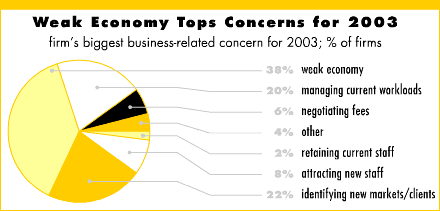

Coping with a weak economy tops 2003 list of concerns

Work-on-the-Boards
Survey
by Kermit Baker, PhD, Hon. AIA
AIA Chief Economist
A lot of architecture firms ended up with a lump of coal in their stocking this holiday season. Due to time off for the holidays by both architecture firm staff and their clients, December is traditionally a slow time for work at firms. This year, the downturn was particularly sharp, as almost 30 percent of firms reported a drop in billings compared to November levels. Inquiries for new projects also raise concerns: They recorded the sharpest drop since the days after the September 11, 2001, terrorist attacks.
 The
weakness in business conditions was widespread in December. Firms in all
regions reported at least a minor drop, with firms in the Northeast and
West reporting more substantial declines. Even residential firms are beginning
to feel weaker conditions—both billings and inquiries were off significantly
at firms that concentrate in the residential sector. Commercial/industrial
firms reported weak billings and stable inquiries, while institutional
firms reported stable billings and inquiries.
The
weakness in business conditions was widespread in December. Firms in all
regions reported at least a minor drop, with firms in the Northeast and
West reporting more substantial declines. Even residential firms are beginning
to feel weaker conditions—both billings and inquiries were off significantly
at firms that concentrate in the residential sector. Commercial/industrial
firms reported weak billings and stable inquiries, while institutional
firms reported stable billings and inquiries.
The broader economy is sending out mixed signals, although more indicators tend to be on the negative side of the ledger. The employment situation is very troubling. Payrolls declined by 100,000 in December, on top of 90,000 in November. For the year, over 1.1 million positions were lost, the largest decline in a decade. The national unemployment rate remained at 6.0 percent in December. Retail sales were weak in the critical fourth quarter, increasing just 2 percent above fourth quarter retail sales in 2001. Still, retail sales for the year were up 3.4 percent, almost matching the 3.7 percent annual increase in 2001.

Consumer sentiment figures are showing signs of improvement. The December increase in the University of Michigan index was on top of a solid increase in November, so it may be that recent good news from Wall Street is making consumers more comfortable. Business executives are feeling better also, according to the fourth quarter figures from the Conference Board CEO Business Confidence survey.
The worry list
The economy remains atop the list of business concerns for architecture
firms in 2003. When asked to name their biggest concern for 2003, 38 percent
of firms put a weak economy in the number one position, while an additional
22 percent placed identifying new markets or new clients at the top of
their worry list.

Exactly a year ago, we asked the same firms the same question, and a weak economy again headed the list, but was mentioned by only 26 percent of firms. Last year, attracting new staff was voiced frequently, with 17 percent of firms putting it at the top of the list. After a year of softer business conditions, firms seem less concerned about recruiting new staff, or even retaining current staff, and only 2 percent of firms put this issue at the top of the list.
However, larger firms still are concerned about staffing issues. Almost one in five firms with billings over $1 million put retaining or attracting staff as their principal concern for the coming year. Smaller firms were more likely to list managing project workloads (30 percent) or negotiating appropriate fees (9 percent) as their chief concern for the coming year.
Copyright 2003 The American Institute of Architects. All rights reserved.
![]()
 |
||
| This month, Work-on-the-Boards-survey participants are saying: “Business conditions in the Southeast seem to be improving.” “We have seen increases in many overhead costs. Our challenge
this year will be to negotiate higher fees for new work and complete
existing projects within negotiated fees.” “We have lots of work on temporary hold, awaiting re-approvals
on environmental issues.” “The poor economy has curtailed almost all public funding.” |
||